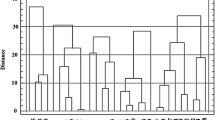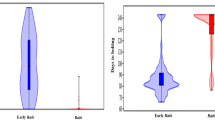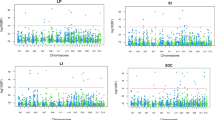Abstract
Heat stress, especially during the reproductive stage, has been exacerbated by changing climatic conditions, resulting in reduced seed yield in crops like Indian mustard. In the present study, 154 genotypes of Indian mustard were used to find novel SSR marker-based associations for seed yield and physiological traits by linkage disequilibrium. Extensive phenotyping of 154 genotypes for seed yield and various physiological traits was done for two consecutive years (2020–2021 and 2021–2022) in timely and late-sown environments. Out of 237 SSR markers, a total of 111 polymorphic markers containing 312 alleles were used for analysis. Two different models, i.e., general linear model (GLM) and mixed linear model (MLM), were used to detect the significant marker–trait associations for timely and late-sown environment separately. A total of 12 and 10 MTAs were found to be associated under timely and late-sown conditions with seed yield and physiological traits using MLM model. Out of these promising MTAs identified in the present study, five SSRs were specifically detected only in late-sown environments which meant that these specific genomic regions and QTLs were associated under terminal heat conditions. This is the first report on the identification of marker-trait associations for physiological traits under terminal heat stress conditions. It may be possible to develop the molecular markers for significant SSRs after due validation. The findings contribute to our understanding of the genetic basis of heat tolerance and provide valuable information for breeding programs aiming to improve crop productivity under heat stress conditions.










Similar content being viewed by others
Availability of Data and Materials
The raw data supporting the conclusions of this article will be made available by the authors, without undue reservation.
References
Aakanksha YSK, Yadav BG et al (2021) Genetic analysis of heterosis for yield influencing traits in Brassica juncea using a doubled haploid population and its backcross progenies. Front Plant Sci 12:721631
Ahmad M, Waraich EA, Skalicky M, Hussain S, Zulfiqar U, Anjum MZ, Habib ur Rahman M, Brestic M, Ratnasekera D, Lamilla-Tamayo L, and Al-Ashkar I (2021) Adaptation strategies to improve the resistance of oilseed crops to heat stress under a changing climate: An overview. Front Plant Sci 12:767150
Akhatar J, Banga SS (2015) Genome-wide association mapping for grain yield components and root traits in Brassica juncea (L.) Czern & Coss. Mol Breeding 35:1–14
Akhatar J, Goyal A, Kaur N et al (2021) Genome wide association analyses to understand genetic basis of flowering and plant height under three levels of nitrogen application in Brassica juncea (L.) Czern & Coss. Scientific Reports 11:4278
Akter N, Rafiqul Islam M (2017) Heat stress effects and management in wheat. A Review Agronomy for Sustainable Development 37:1–17
Alam MM, Begum F, Roy P (2014) Yield and yield attributes of rapeseed mustard (Brassica) genotypes grown under late sown condition. Bangladesh J Agric Res 39:311–336
Baghel RS, Srivastava SBL (2010) Assessment of mustard genotypes for thermo tolerance at seed development stage. Indian J Plant Physiol 15:36–43
Barik SR, Pandit E, Mohanty SP et al (2020) Genetic mapping of physiological traits associated with terminal stage drought tolerance in rice. BMC Genet 21:1–12
Bradbury PJ, Zhang Z, Kroon DE, Casstevens TM, Ramdoss Y, Buckler ES (2007) TASSEL: software for association mapping of complex traits in diverse samples. Bioinformatics 23:2633–2635
Breseghello F, Sorrells ME (2006) Association mapping of kernel size and milling quality in wheat (Triticum aestivum L.) cultivars. Genetics 172:1165–1177
Cai D, Xiao Y, Yang W et al (2014) Association mapping of six yield-related traits in rapeseed (Brassica napus L.). Theor Appl Genet 127:85–96
Chauhan JS, Meena ML, Saini MK et al (2009) Heat stress effects on morpho-physiological characters of Indian mustard (Brassica juncea L.). 16th Australian Research Assembly on Brassicas, Ballarat Victoria 91–97
Chen S, Stefanova K, Siddique KH, Cowling WA (2021) Transient daily heat stress during the early reproductive phase disrupts pod and seed development in Brassica napus L. Food Energy Secur 10(1):262
Choudhary RR, Avtar R, Kumar P et al (2022) Molecular and morphological diversity of the mori CMS lines and restores in Indian mustard (Brassica juncea L.). Journal of Oilseed Brassica 13:94–99
Chugh P, Sharma P, Sharma R, Singh M (2022) Study on heat stress indices and their correlation with yield in Indian mustard genotypes under diverse conditions. Indian Journal of Genetics and Plant Breeding 82:186–192
de Almeida LMM, Coquemont-Guyot M, Elie N, Morvan-Bertrand A, Avice JC, Mollier A, Brunel-Muguet S (2023) Repeated heat stress events during the reproductive phase impact the dynamic development of seeds in Brassica napus L. Plant Sci 327:111559
De Costa W (2011) A review of the possible impacts of climate change on forests in the humid tropics. J Natl Sci Found Sri 39:281–302
Dhaka N, Rout K, Yadava SK et al (2017) Genetic dissection of seed weight by QTL analysis and detection of allelic variation in Indian and east European gene pool lines of Brassica juncea. Theor Appl Genet 130:293–307
Dhaliwal LK, Hundal SS, Chahal SK (2007) Agroclimatic indices of Indian mustard (Brassica juncea) under Punjab conditions. Indian Journal of Agricultural Science 77:88–91
Earl DA, VonHoldt BM (2012) STRUCTURE HARVESTER: a website and program for visualizing STRUCTURE output and implementing the Evanno method. Conserv Genet Resour 4:359–361
Evans M, Moore D, McCabe G (2000) Minitab manual for introduction to the practice of statistics. University of Toronto
Fischer RA, Maurer R (1978) Drought resistance in spring wheat cultivars. I. Grain yield responses. Aust J Agric Res 29:897–912
GOI G (2022) 2nd Advance Estimates. (As on 14th February, 2023). Indian Vanaspati Producer’s Association, Govt. of India. (16687) & Ministry of Agriculture & Farmers Welfare, Govt. of India. (ON3057) & Past Issues
Grilli GVG, Braz LT, Lemos EGM (2007) QTL identification for tolerance to fruit set in tomato by fAFLP markers. Crop Breeding and Applied Biotechnology 234–241
Gupta PK, Rustgi S, Kulwal PL (2005) Linkage disequilibrium and association studies in higher plants: present status and future prospects. Plant Mol Biol 57:461–485
Gupta N, Gupta M, Akhatar J et al (2021) Association genetics of the parameters related to nitrogen use efficiency in Brassica juncea L. Plant Mol Biol 10:
Hasanuzzaman M, Nahar K, Alam MM, Fujita M (2014) Modulation of antioxidant machinery and the methylglyoxal detoxification system in selenium-supplemented Brassica napus seedlings confers tolerance to high temperature stress. Biol Trace Elem Res 161:297–307
Hiscox JD, Israelstam GF (1979) A method for the extraction of chlorophyll from leaf tissue without maceration. Can J Bot 57:1332–1334
Huang R, Liu Z, Xing M, Yang Y, Wu X, Liu H, Liang W (2019) Heat stress suppresses Brassica napus seed oil accumulation by inhibition of photosynthesis and BnWRI1 pathway. Plant Cell Physiol 60(7):1457–1470
IBEF I (2022) https://www.ibef.org/exports/oilseeds-industry-india
Jannink J-L, Bink MC, Jansen RC (2001) Using complex plant pedigrees to map valuable genes. Trends Plant Sci 6:337–342
Javid S, Bihamta MR, Omidi M et al (2022) Genome-Wide Association Study (GWAS) and genome prediction of seedling salt tolerance in bread wheat (Triticum aestivum L.). BMC Plant Biology 22:581
Jestin C, Lodé M, Vallée P et al (2011) Association mapping of quantitative resistance for Leptosphaeria maculans in oilseed rape (Brassica napus L.). Mol Breeding 27:271–287
Kavita PA, Pandey A (2017) Physiological attributes for screening of Indian mustard (Brassica juncea L. Czern and Coss) genotypes during terminal heat stress. Int J Curr Micro Appl Sci 6:2908–2913
Körber N, Bus A, Li J et al (2016) Agronomic and seed quality traits dissected by genome-wide association mapping in Brassica napus. Front Plant Sci 7:386
Kourani M, Mohareb F, Rezwan FI, Anastasiadi M, Hammond JP (2022) Genetic and physiological responses to heat stress in Brassica napus. Front Plant Sci 13:832147
Kumar S, Sairam RK, Prabhu KV (2013) Physiological traits for high temperature stress tolerance in Brassica juncea. Indian J Plant Physiol 18:89–93
Kumar P, Nimbal S, Sangwan RS et al (2021) Identification of novel marker–trait associations for lint yield contributing traits in upland cotton (Gossypium hirsutum L.) using SSRs. Frontiers in plant science 12:653270
Li S, Fu Q, Chen L et al (2011) Arabidopsis thaliana WRKY25, WRKY26, and WRKY33 coordinate induction of plant thermotolerance. Planta 233:1237–1252
Liu J, Wang W, Mei D et al (2016) Characterizing variation of branch angle and genome-wide association mapping in rapeseed (Brassica napus L.). Frontiers in plant science 7:21
Longmei N, Gill GK, Zaidi PH et al (2021) Genome wide association mapping for heat tolerance in sub-tropical maize. BMC Genomics 22:1–14
Lucas MR, Ehlers JD, Huynh B-L et al (2013) Markers for breeding heat-tolerant cowpea. Mol Breeding 31:529–536
Luo X, Ma C, Yue Y et al (2015) Unravelling the complex trait of harvest index in rapeseed (Brassica napus L.) with association mapping. BMC Genomics 16:1–10
Lv H, Miyaji N, Osabe K, Akter A, Mehraj H, Shea DJ, and Fujimoto R (2020) The importance of genetic and epigenetic research in the Brassica vegetables in the face of climate change. Genomic designing of climate-smart vegetable crops, pp.161–255
Mácová K, Prabhullachandran U, Štefková M, Spyroglou I, Pěnčík A, Endlová L, Novák O, Robert HS (2022) Long-term high-temperature stress impacts on embryo and seed development in Brassica napus. Front Plant Sci 13:844292
Mácová K, Prabhullachandran U, Spyroglou I, Štefková M, Pěnčík A, Endlová L, Novák O, and Robert HS (2021) Effects of long-term high-temperature stress on reproductive growth and seed development in development in Brassica napus. bioRxiv, pp.2021–03
Malysheva-Otto LV, Ganal MW, Röder MS (2006) Analysis of molecular diversity, population structure and linkage disequilibrium in a worldwide survey of cultivated barley germplasm (Hordeum vulgare L.). BMC Genet 7:1–14
Meena DR, Chauhan JS, Singh M et al (2013) Genetic variation and correlations among physiological characters in Indian mustard (Brassica juncea L.) under high temperature stress
Morrison MJ, Stewart DW (2002) Heat stress during flowering in summer Brassica. Crop Sci 42:797–803
Nagaharu U, Nagaharu N (1935) Genome analysis in Brassica with special reference to the experimental formation of B. napus and peculiar mode of fertilization. Jpn J Bot 7:389–452
Nagarajan S, Jagadish SVK, Prasad AH et al (2010) Local climate affects growth, yield and grain quality of aromatic and non-aromatic rice in northwestern India. Agr Ecosyst Environ 138:274–281
Nuttall WF, Moulin AP, Townley-Smith LJ (1992) Yield response of canola to nitrogen, phosphorus, precipitation, and temperature. Agron J 84:765–768
Pokharel M, Chiluwal A, Stamm M, Min D, Rhodes D, Jagadish SK (2020) High night-time temperature during flowering and pod filling affects flower opening, yield and seed fatty acid composition in canola. J Agron Crop Sci 206(5):579–596
Pritchard JK, Stephens M, Donnelly P (2000) Inference of population structure using multilocus genotype data. Genetics 155:945–959
Rafalski JA (2002) Novel genetic mapping tools in plants: SNPs and LD-based approaches. Plant Sci 162:329–333
Rahman M, Hoque A, Roy J (2022) Linkage disequilibrium and population structure in a core collection of Brassica napus (L.). Plos one 17:e0250310
Ramchiary N, Padmaja KL, Sharma S et al (2007) Mapping of yield influencing QTL in Brassica juncea: implications for breeding of a major oilseed crop of dryland areas. Theor Appl Genet 115:807–817
Ranjan P, Yin T, Zhang X et al (2010) Bioinformatics-based identification of candidate genes from QTLs associated with cell wall traits in Populus. Bioenergy Research 3:172–182
Remington DL, Thornsberry JM, Matsuoka Y et al (2001) Structure of linkage disequilibrium and phenotypic associations in the maize genome. Proc Natl Acad Sci 98:11479–11484
Risch NJ (2000) Searching for genetic determinants in the new millennium. Nature 405:847–856
Sandhu SK, Pal L, Kaur J, Bhatia D (2019) Genome wide association studies for yield and its component traits under terminal heat stress in Indian mustard (Brassica juncea L.). Euphytica 215:1–15
Scafaro AP, Haynes PA, Atwell BJ (2010) Physiological and molecular changes in Oryza meridionalis Ng., a heat-tolerant species of wild rice. J Exp Bot 61:191–202
Sharma P (2014) Heat tolerance in Indian mustard at seedling and terminal stages. Ann Plant Soil Res 16:224–228
Sharma P, Sardana V (2016) Screening of Indian mustard (Brassica juncea) for thermo tolerance at seedling and terminal stages. Journal of Oilseed Brassica 1:61–67
Sharma D, Nanjundan J, Singh L et al (2022a) Genetic diversity and population structure analysis in Indian Mustard germplasm using phenotypic traits and SSR markers. Plant Mol Biol Report 40:579–594
Sharma HK, Singh VV, Kumar A et al (2022b) Genetic study of terminal heat stress in indigenous collections of Indian mustard (Brassica juncea L.) germplasm. J Environ Biol 43:161–169
Shi J, Li R, Qiu D et al (2009) Unraveling the complex trait of crop yield with quantitative trait loci mapping in Brassica napus. Genetics 182:851–861
Singh M, Avtar R, Singh VK et al (2021) Genetic diversity in Indian mustard (Brassica juncea) genotypes for Sclerotinia stem rot (Sclerotinia sclerotiorum) using SSR markers. Indian J Agric Sci 91:914–919
Singh V, Pant U, Bhajan R (2016) Physiological traits versus seed yield derived parameters based heat stress study in Indian mustard. SABRAO Journal of Breeding & Genetics 48:
Singh RK (1985) Biometrical methods in quantitative genetic analysis. Kalyani Pub. Ludhiana. New Delhi, Revised Ed 318:
Tafesse EG, Gali KK, Lachagari VR, Bueckert R, Warkentin TD (2020) Genome-wide association mapping for heat stress responsive traits in field pea. Int J Mol Sci 21(6):2043
Thakur AK, Parmar N, Singh KH, Nanjundan J (2020) Current achievements and future prospects of genetic engineering in Indian mustard (Brassica juncea L. Czern & Coss.). Planta 252:1–20
Thakur AK, Singh KH, Parmar N et al (2021) Population structure and genetic diversity as revealed by SSR markers in Ethiopian mustard (Brassica carinata A. Braun): a potential edible and industrially important oilseed crop. Genet Resour Crop Evol 68:321–333
Tuteja SS, Lakpale R, Tripathi RS (1996) Effect of date of sowing, nitrogen level and nitrogen splitting on mustard (B. juncea). Adv Plant Sci 9:167–168
Ul Hassan M, Rasool T, Iqbal C, Arshad A, Abrar M, Abrar MM, Habib-ur-Rahman M, Noor MA, Sher A, and Fahad S (2021) Linking plants functioning to adaptive responses under heat stress conditions: a mechanistic review. Journal of Plant Growth Regulation, pp.1–18
Wang D, Heckathorn SA, Barua D et al (2008) Effects of elevated CO2 on the tolerance of photosynthesis to acute heat stress in C3, C4, and CAM species. Am J Bot 95:165–176
Wellburn AR (1994) The spectral determination of chlorophylls a and b, as well as total carotenoids, using various solvents with spectrophotometers of different resolution. J Plant Physiol 144:307–313
Yadava SK, Arumugam N, Mukhopadhyay A et al (2012) QTL mapping of yield-associated traits in Brassica juncea: meta-analysis and epistatic interactions using two different crosses between east European and Indian gene pool lines. Theor Appl Genet 125:1553–1564
Ye C, Tenorio FA, Argayoso MA et al (2015) Identifying and confirming quantitative trait loci associated with heat tolerance at flowering stage in different rice populations. BMC Genet 16:1–10
Young LW, Wilen RW, Bonham-Smith PC (2004) High temperature stress of Brassica napus during flowering reduces micro-and megagametophyte fertility, induces fruit abortion, and disrupts seed production. J Exp Bot 55:485–495
Yu S, Zhang F, Wang X et al (2010) Genetic diversity and marker-trait associations in a collection of Pak-choi (Brassica rapa L. ssp. chinensis Makino) Accessions. Genes & Genomics 32:419–428
Zhang W, Hu D, Raman R et al (2017) Investigation of the genetic diversity and quantitative trait loci accounting for important agronomic and seed quality traits in Brassica carinata. Front Plant Sci 8:615
Zondervan KT, Cardon LR (2004) The complex interplay among factors that influence allelic association. Nat Rev Genet 5:89–100
Acknowledgements
The authors gratefully acknowledge Dr. Naveen Singh (Scientist, IARI, New Delhi) and Dr. P. K. Rai (Principal Scientist and Director, Directorate of Rapeseed and Mustard Research, Bharatpur) for providing the seed material for the research experiment. Authors are also thankful to CSIR (Council of Scientific and Industrial Research)- HRDG, New Delhi, for awarding the Senior Research Fellowship to Raju Ram Choudhary during his doctorate study.
Author information
Authors and Affiliations
Contributions
RRC: conducted the research, recorded data, and drafted the manuscript; RA: supervision, guidance, planning of experiment, and manuscript editing; PK: statistical analysis, data interpretation, and manuscript editing; MS: assisted in wet lab work; MB: manuscript editing; NK: crop management and technical help; RP: crop management and data recording.
Corresponding author
Ethics declarations
Ethical Approval
The authors declare that the results described in this article are entirely produced by themselves from their original research work.
Competing Interests
The authors declare no competing interests.
Additional information
Publisher's Note
Springer Nature remains neutral with regard to jurisdictional claims in published maps and institutional affiliations.
Supplementary Information
Below is the link to the electronic supplementary material.
Rights and permissions
Springer Nature or its licensor (e.g. a society or other partner) holds exclusive rights to this article under a publishing agreement with the author(s) or other rightsholder(s); author self-archiving of the accepted manuscript version of this article is solely governed by the terms of such publishing agreement and applicable law.
About this article
Cite this article
Choudhary, R.R., Avtar, R., Kumar, P. et al. Dissection of Physiological Traits for Terminal Heat Stress Tolerance in Indian Mustard (Brassica juncea L.) Using Microsatellite Markers. Plant Mol Biol Rep (2024). https://doi.org/10.1007/s11105-024-01456-3
Received:
Accepted:
Published:
DOI: https://doi.org/10.1007/s11105-024-01456-3




